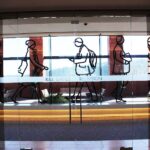The newest thing in office design sounds a lot like the newest thing in groceries: “organic design.”
The newest thing in office design sounds a lot like the newest thing in groceries. Called organic design, organic planning or, if you prefer, phylogenetic design, the trend in building cubicle farms is taking cues from the great outdoors.
Forget 90-degree angles and tall metal dividers. Organically planned offi ces aim for airy with natural light, better ventilation and views to nature. They also have workspaces that fit together in a honeycomb-inspired design with desks that have 120-degree sweeps, accommodating the prevailing work methodology: piles of work spread out on each side with a computer keyboard in the middle.
“In our fathers’ world, people worked their entire lives to get into the corner office. Today, most people don’t care,” says Tess Healey, vice president at Pacific Offi ce Furnishing in Portland. Workplaces these days tend to be more collaborative, Healey says, and organic office design supports that with lower dividers and more places to gather for impromptu meetings.
Annie Johnson, owner of Windermere/Johnson Real Estate in Wilsonville, recently used organic design principles in an office redesign. She was able to fi t worksites for more agents using the 120-degree desks and made strategic use of low dividers, glass and neutral tones to give the space an airy feel. “It really made sense for our offi ce and nobody’s tucked back in a corner.”
Fitting together the 120-degree desktops results in honeycomb-like confi gurations, which ends up leaving room for more shared space and more workstations than the old 90-degree-oriented cubicles. Views to the outside world are also important, picking up on recent research that shows that patients who can see nature through their hospital room windows heal more quickly than patients who can’t.
“If employees are more productive, there’s money attached to that,” says Bonnie Campbell, account development manager for furniture company Herman Miller, the originator of the cubicle (along with the Aeron office chair) and a proponent of organic office design.
Robert Probst, a designer hired by Herman Miller in the 1960s, was the first to come up with workspaces that evolved to become standard cubicles. His original vision, Campbell says, is much closer to the organic designs being promoted these days.
— Christina Williams


